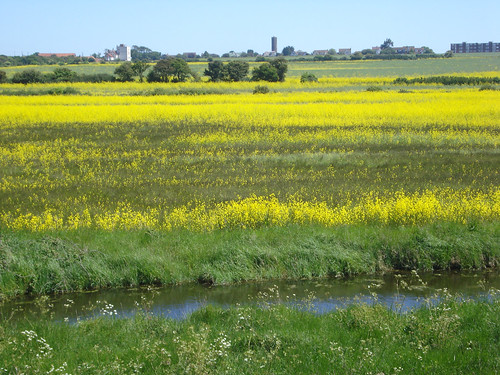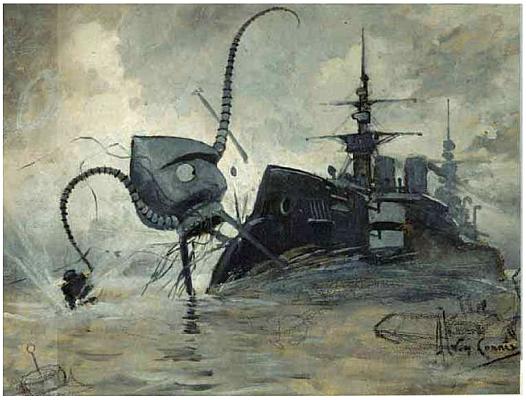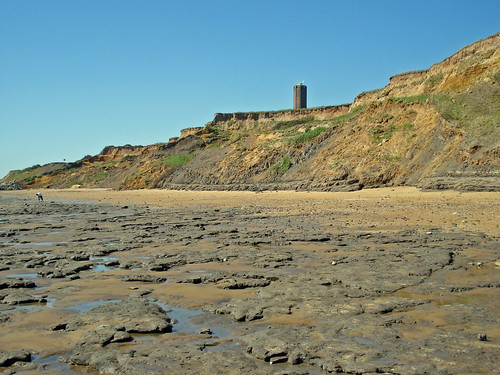
Looking “inland” from the backwaters to the sea and the Naze tower. The sea is all around you here.
I continued to scan the horizon, the backwaters is made up of numerous creeks snaking among low lying islands. When the tide he water is all but level with most of these islands. It is not an alien landscape, but it is foreign. It's inaccessibility has meant rare species have been able to remain. One of the larger islands has permanent wardens on it to make sure things remain as they are.
On one of those islands lurks a rare plant. That rare plant is food to the Fisher Estuarine Moth. The island has the only viable colony of them in Britain. The island will flood at some future point, probably sooner rather than later. That flood will probably be the end of the moth.

Image by oldbilluk via Flickr
The area has an inhospitable bleakness about it, even under bright blue skies. I have long left behind the most adventurous of the waddlers, I have the place to myself.
The human activity is confined to the water where people fiddle with their boats. A boat advertising wild life trips goes past, it is full of people. I wonder what they may have seen, but for most being on the water surrounded by the landscape is probably treat enough. There is a lot to sea and hear, although due to the noise of the boat engine, a bit less too see and a lot less to hear.
I am always conscious of walking on the edge of the map when coast walking. Some Canada geese go overhead making plenty of din about it, they join some others in a field, some contented cows continue chewing.
I reach a point where the land runs out and I have to make a right angle turn to follow the coastline. The views are 360. I can see the square church tower of the town, and through the trees with binoculars I can make out two other church towers and various isolated farms and grand houses. Roads do not figure in the landscape, nothing mechanical moves for the miles the eye can see on land.
The one feature is Felixstowe docks, the loading/unloading cranes are impressive, it is difficult not to imagine them as an alien invasion force. The plucky Thunder-Child set sail from Harwich in H.G Wells, War of the Worlds. The Naze being somewhere the aliens had chosen as an invasion point. It was always one of my favourite moments in the book, a daydream takes over me for a while.

(1906 book illustration War of the Worlds)
Wish I had bought a map so I could identify all the features. I did not need a map to follow a coastline, all I have is a sketch and some gps waypoints. I do not even have a compass to take bearings and check later. I could have started getting inventive to determine the bearings but wasn't in the mood. Too hot for problem solving, even the most mundane.
Still no seals. A tern is trying to tell me something. A kestrel is using the offshore wind rising off the embankment to make his hover easier. I briefly hope the things that scurry in the embankment undergrowth keep their heads down. A job not made easier by the fact it seems to have recently been cut back.
The drainage ditch, which has the aspect of a river plays host to a coot and a family of ducks. Freshwater, it must be the source of the earth I am standing on, a tiny bit of deduction I am overly pleased with.
Briefly wild swimming bubbles to the surface of my mind. There is no safe place to get in and out (I tell myself) and this experience is put off for another day without too much loss of face.

Image via Wikipedia
Once I take this turn the terrain changes somewhat and seal spotting becomes increasingly unlikely. A noisy oystercatcher sitting on a tuft of grass growing out of the salt marsh gives me a send off.
Walking through dry grass I disturb countless grasshoppers, they leap in profusion just keen to escape me. Seldom have I seen so many. Along with these myriad ladybirds, they are suddenly everywhere, it transports me back to the legendary summer of 76 where we had a plague of the things, sweeping them off doorsteps. I hope they are our native ladybirds, those naughty imports are causing mayhem, lets hope this summer is not so generous to their numbers.
I reach the sea, a point at which the crumbling Naze cliffs sink into the sand, exhausted. I decide to strike out onto the narrow strip of sand which separates backwater from sea. The sand looks dry and the detritus aged, the sea does not wash over these sands often by the looks of it. The wind is weak, and the moon phase promises small tides. All suggests if I have guessed the direction of the tide (I consider it is going out) I am not going to be cut off.

Even if I have got all this wrong, there looks to be sufficient green tussock grass to suggest I could sit out my error till the tide went back out. If all that fails and embarrassed called to the local lifeboat, if that fails then maybe I drown. Its a long set of circumstances before that eventuality, more chance crashing the car on the way home. Still if you don't give these things respect they will teach it too you the hard way.
Onto the soft hot sand I step. There is always flotsam and jetsum in these sorts of places, mostly indestructible plastic water bottles and those useless plastic forks that don't have the strength to lance a chip but will last forever it seems.
I select a bottle to replace my meths bottle. Its got one of those clever cap designs which makes accidental spillage near impossible. Re-use is better than recycle. Some rubber, maybe wetsuit remnant, goes into the bag, near bombproof firelighting material.
Looking back towards the cliff I see small knots of people hunched over double. They are looking for sharks teeth. Some people seem to have spent a lifetime filling matchboxes with them. Others seem intent on filling plastic bags with seashells. Leave the damn seashells where they belong, take home the plastic bottles.
My eyes are scanning the sands for a seashell though. I am looking for a whelk shell that spirals in the opposite direction. Modern ones spiral one way, ones from the fossil record go the opposite way, or at least that is what I learnt as a small child in the land locked midlands. From the vantage point of my wooden lift top desk with generations of graffiti etched into it, the seaside was as exotic as it got. The idea of children learning at ancient Victorian desks now seems exotic.
It gives me something to do, there is a limit to how much the senses can grasp of a flat land a few inches above a flat sea. My hat is pretty much the highest point for some miles.
Eventually without finding anything more than endless ladybirds, one of which I ludicrously saved from a small rock pool (well I could not let it drown) I ran out of land. I had reached the tip of stone point, or at least what the tide had revealed, to go further would be tempting fate for no gain other than taking a risk. Years ago I could have walked further, years from now I will not be able to walk this far, all in living memory. Coastal erosion is something you can chart year on year in this part of England.
Time to turn back. I simply retracted my footsteps, easy to do, they were there in the soft sand along with bird tracks and the tracks of what I presume was the lifeguard 4x4 searching for some unfortunate.
I never did see a grey seal, but I saw a lot more and the place, despite my initial impression, had a natural wildness which was quite unexpected.


No comments:
Post a Comment